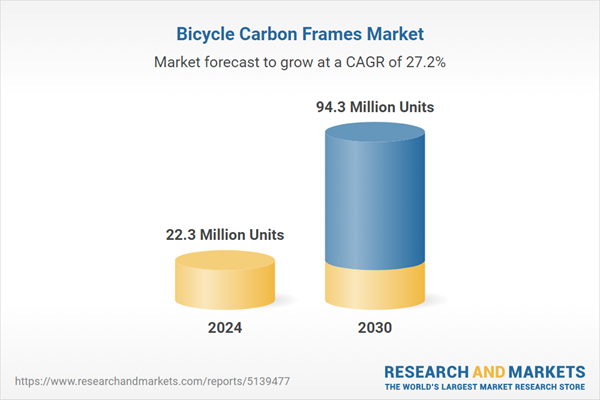The global market for Bicycle Carbon Frames was sized at 22.3 Million Units in 2024 and is projected to reach 94.3 Million Units by 2030, growing at a CAGR of 27.2% over the analysis period 2024-2030. This comprehensive report provides an in-depth analysis of market trends, drivers, and forecasts, helping you make informed business decisions. The report includes the most recent global tariff developments and how they impact the Bicycle Carbon Frames market.
Segments: Segment (Bicycle Carbon Frames).
Geographic Regions/Countries: World; United States; Canada; Japan; China; Europe (France; Germany; Italy; United Kingdom; Spain; Russia; and Rest of Europe); Asia-Pacific (Australia; India; South Korea; and Rest of Asia-Pacific); Latin America (Argentina; Brazil; Mexico; and Rest of Latin America); Middle East (Iran; Israel; Saudi Arabia; United Arab Emirates; and Rest of Middle East); and Africa.
The analysts continuously track trade developments worldwide, drawing insights from leading global economists and over 200 industry and policy institutions, including think tanks, trade organizations, and national economic advisory bodies. This intelligence is integrated into forecasting models to provide timely, data-driven analysis of emerging risks and opportunities.
Global Bicycle Carbon Frames Market - Key Trends and Drivers Summarized
What Makes Bicycle Carbon Frames So Revolutionary?
Bicycle carbon frames have revolutionized the cycling industry, offering a blend of performance, durability, and aesthetic appeal that few other materials can match. Carbon fiber is an incredibly strong and lightweight material, composed of thin strands of carbon that are woven together and set in a resin matrix. This unique construction provides several advantages over traditional materials like aluminum and steel. For one, carbon fiber frames are much lighter, which can significantly enhance speed and maneuverability, especially in competitive cycling. Additionally, carbon frames can be engineered to optimize stiffness in key areas - such as the bottom bracket and head tube - while allowing for flexibility in others, like the seat stays, to absorb road vibrations. This tunable property makes carbon frames highly versatile, catering to a wide range of riding styles, from aggressive racing to long-distance touring. The ability to create complex shapes and integrate aerodynamic features directly into the frame design further distinguishes carbon fiber as the material of choice for high-performance bicycles.How Do Manufacturing Techniques Impact the Quality and Cost of Carbon Frames?
The process of manufacturing carbon frames is both an art and a science, with significant implications for the final product's quality and cost. Unlike metal frames, which are typically welded together from tubes, carbon fiber frames are molded from sheets of carbon fabric that are layered into molds and then cured in an oven. This process, known as layup, requires precision and expertise, as the orientation and number of layers affect the frame's strength, weight, and ride characteristics. The use of advanced techniques like monocoque construction, where the frame is molded as a single piece, further enhances the integrity and performance of the frame. However, these manufacturing processes are labor-intensive and require specialized equipment, which contributes to the higher cost of carbon frames. In recent years, advancements in automated layup techniques and 3D printing have started to reduce production times and costs, making carbon frames more accessible to a broader range of cyclists. Nevertheless, the quality of a carbon frame is still largely dependent on the craftsmanship involved, with top-tier frames often produced by hand to ensure meticulous attention to detail.What Are the Key Trends Shaping the Bicycle Carbon Frame Market?
The bicycle carbon frame market is evolving rapidly, influenced by a combination of technological advancements, changing consumer preferences, and environmental considerations. One of the most significant trends is the increasing use of computational design tools, such as finite element analysis (FEA), which allows engineers to simulate and optimize frame performance before a prototype is even built. This has led to the development of carbon frames that are not only lighter and stronger but also more aerodynamic and comfortable. Another trend is the growing emphasis on sustainability, with manufacturers exploring the use of recycled carbon fiber and bio-based resins to reduce the environmental impact of production. Additionally, the rise of e-bikes has spurred the development of carbon frames designed specifically to handle the unique stresses and weight of electric motors and batteries. Customization is also becoming a key trend, as consumers seek frames tailored to their specific body dimensions and riding preferences. With the advent of direct-to-consumer sales models, cyclists now have more options to personalize their frames, from paint schemes to geometry, further driving innovation in the carbon frame market.What’s Driving the Growth of the Bicycle Carbon Frame Market?
The growth in the bicycle carbon frame market is driven by several factors, reflecting broader trends in cycling technology, consumer demand, and lifestyle shifts. First, the increasing popularity of cycling as both a recreational activity and a competitive sport has fueled demand for high-performance bicycles, where carbon frames are often seen as essential for those seeking a competitive edge. Second, the global push towards environmental sustainability has encouraged more people to adopt cycling as a mode of transportation, boosting demand for lightweight and durable carbon frames that can withstand daily use. Technological advancements, such as improved carbon fiber materials and more efficient manufacturing processes, have also contributed to making carbon frames more affordable and accessible, expanding their appeal beyond professional cyclists to a wider audience. Additionally, the growth of urban cycling and bike-sharing programs has created a market for carbon frames that are both rugged and lightweight, ideal for navigating city environments. The rise of gravel and adventure cycling has further driven demand for carbon frames capable of handling mixed terrains while offering comfort and durability. Collectively, these factors are not only propelling the growth of the bicycle carbon frame market but are also shaping its future trajectory, making it one of the most dynamic sectors in the cycling industry.Report Scope
The report analyzes the Bicycle Carbon Frames market, presented in terms of units. The analysis covers the key segments and geographic regions outlined below.Segments: Segment (Bicycle Carbon Frames).
Geographic Regions/Countries: World; United States; Canada; Japan; China; Europe (France; Germany; Italy; United Kingdom; Spain; Russia; and Rest of Europe); Asia-Pacific (Australia; India; South Korea; and Rest of Asia-Pacific); Latin America (Argentina; Brazil; Mexico; and Rest of Latin America); Middle East (Iran; Israel; Saudi Arabia; United Arab Emirates; and Rest of Middle East); and Africa.
Regional Analysis
Gain insights into the U.S. market, sized at 5.4 Million Units in 2024, and China, forecasted to grow at an impressive 33.4% CAGR to reach 28.0 Million Units by 2030. Discover growth trends in other key regions, including Japan, Canada, Germany, and the Asia-Pacific.Why You Should Buy This Report:
- Detailed Market Analysis: Access a thorough analysis of the Global Bicycle Carbon Frames Market, covering all major geographic regions and market segments.
- Competitive Insights: Get an overview of the competitive landscape, including the market presence of major players across different geographies.
- Future Trends and Drivers: Understand the key trends and drivers shaping the future of the Global Bicycle Carbon Frames Market.
- Actionable Insights: Benefit from actionable insights that can help you identify new revenue opportunities and make strategic business decisions.
Key Questions Answered:
- How is the Global Bicycle Carbon Frames Market expected to evolve by 2030?
- What are the main drivers and restraints affecting the market?
- Which market segments will grow the most over the forecast period?
- How will market shares for different regions and segments change by 2030?
- Who are the leading players in the market, and what are their prospects?
Report Features:
- Comprehensive Market Data: Independent analysis of annual sales and market forecasts in US$ Million from 2024 to 2030.
- In-Depth Regional Analysis: Detailed insights into key markets, including the U.S., China, Japan, Canada, Europe, Asia-Pacific, Latin America, Middle East, and Africa.
- Company Profiles: Coverage of players such as Alan Bikes, Battaglin Italia Srls, BBB Cycling, Canyon Bicycles GmbH, Cicli Pinarello S.r.l. and more.
- Complimentary Updates: Receive free report updates for one year to keep you informed of the latest market developments.
Some of the 42 companies featured in this Bicycle Carbon Frames market report include:
- Alan Bikes
- Battaglin Italia Srls
- BBB Cycling
- Canyon Bicycles GmbH
- Cicli Pinarello S.r.l.
- CKT (Carbon Knowledge Team)
- Concept Cyclery Ballito
- Cycle-Bay International Company Limited
- DEMA Senica AS
- Dengfu Sports Equipment Co., Ltd.
Tariff Impact Analysis: Key Insights for 2025
Global tariff negotiations across 180+ countries are reshaping supply chains, costs, and competitiveness. This report reflects the latest developments as of April 2025 and incorporates forward-looking insights into the market outlook.The analysts continuously track trade developments worldwide, drawing insights from leading global economists and over 200 industry and policy institutions, including think tanks, trade organizations, and national economic advisory bodies. This intelligence is integrated into forecasting models to provide timely, data-driven analysis of emerging risks and opportunities.
What’s Included in This Edition:
- Tariff-adjusted market forecasts by region and segment
- Analysis of cost and supply chain implications by sourcing and trade exposure
- Strategic insights into geographic shifts
Buyers receive a free July 2025 update with:
- Finalized tariff impacts and new trade agreement effects
- Updated projections reflecting global sourcing and cost shifts
- Expanded country-specific coverage across the industry
Table of Contents
I. METHODOLOGYII. EXECUTIVE SUMMARY2. FOCUS ON SELECT PLAYERSIII. MARKET ANALYSISIV. COMPETITION
1. MARKET OVERVIEW
3. MARKET TRENDS & DRIVERS
4. GLOBAL MARKET PERSPECTIVE
UNITED STATES
CANADA
JAPAN
CHINA
EUROPE
FRANCE
GERMANY
ITALY
UNITED KINGDOM
SPAIN
RUSSIA
REST OF EUROPE
ASIA-PACIFIC
AUSTRALIA
INDIA
SOUTH KOREA
REST OF ASIA-PACIFIC
LATIN AMERICA
ARGENTINA
BRAZIL
MEXICO
REST OF LATIN AMERICA
MIDDLE EAST
IRAN
ISRAEL
SAUDI ARABIA
UNITED ARAB EMIRATES
REST OF MIDDLE EAST
AFRICA
Companies Mentioned (Partial List)
A selection of companies mentioned in this report includes, but is not limited to:
- Alan Bikes
- Battaglin Italia Srls
- BBB Cycling
- Canyon Bicycles GmbH
- Cicli Pinarello S.r.l.
- CKT (Carbon Knowledge Team)
- Concept Cyclery Ballito
- Cycle-Bay International Company Limited
- DEMA Senica AS
- Dengfu Sports Equipment Co., Ltd.
Table Information
| Report Attribute | Details |
|---|---|
| No. of Pages | 194 |
| Published | April 2025 |
| Forecast Period | 2024 - 2030 |
| Estimated Market Value in 2024 | 22.3 Million Units |
| Forecasted Market Value by 2030 | 94.3 Million Units |
| Compound Annual Growth Rate | 27.2% |
| Regions Covered | Global |









